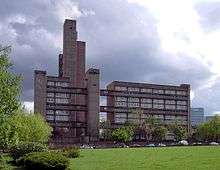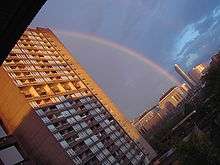Balfron Tower
| Balfron Tower | |
|---|---|
|
Balfron Tower, a prominent example of Brutalist housing | |
| General information | |
| Type | Residential flats |
| Location | Poplar, London, UK |
| Coordinates | 51°30′49.1″N 00°00′31.7″W / 51.513639°N 0.008806°WCoordinates: 51°30′49.1″N 00°00′31.7″W / 51.513639°N 0.008806°W |
| Construction started | 1965 |
| Completed | 1967 |
| Height | |
| Roof | 84 metres (276 ft) |
| Technical details | |
| Floor count | 26 |
| Design and construction | |
| Architect | Ernő Goldfinger |
Balfron Tower is a 26-storey residential building in Poplar, a district of the London Borough of Tower Hamlets in the East End of London. It forms part of the Brownfield Estate, an area of social housing between Chrisp Street Market and the A12 northern approach to the Blackwall Tunnel. It was designed by Ernő Goldfinger in 1963 for the London County Council, built 1965-67 by the GLC, and has been a Grade II listed building since 1996.[1]
Design
Balfron Tower is 84 metres (276 ft) high and contains 146 homes (136 flats and 10 maisonettes).[1] Lifts serve every third floor; thus, to reach a flat on the 11th, 12th or 13th floors, residents or visitors would take a lift to the 12th. The lift shaft sits in a separate service tower, also containing laundry rooms and rubbish chutes, and joined to the residential tower by eight walkways.
The maisonettes are on floors 1 and 2, and 15 and 16, causing a break in the pattern of fenestration on the east side.[2]
The service tower is topped by a boiler room. In 1985 the original concrete boiler flutes were replaced with metal, due to concrete decay.[3]

Carradale House


Carradale House (1967–70) is an adjacent, unique, modernist building, also designed by Ernő Goldfinger and Grade II listed. The two buildings appear to be natural extensions of each other, linked by style and design, with the long, low form of Carradale House complementing the height of Balfron Tower. All flats have dual window aspect and large south facing balconies, allowing plenty of natural light, and decorated with natural wood panels on the sides.[4] The block is 37 metres (121 ft) tall with 11 floors, and contains 88 flats.[5] The building has a similar podium to Balfron Tower, albeit more extensive with a large underground car park underneath. It too has sky bridges on the same principle of access at every third floor. After designing Balfron, Goldfinger identified all the possible improvements and incorporated them first in Carradale House and afterwards to Trellick Tower. Like Balfron Tower, the robust nature of the detailing to this building has helped it to weather the passage of time. Carradale underwent an extensive and careful renovation, that lasted three years under the supervision of English Heritage and the direction of PRP Architects.[6]
The two blocks were known as Rowlett Street Phases I and II during development[3] before being named after the Scottish villages of Balfron and Carradale, a pattern followed in naming other locations on the nearby Aberfeldy and Teviot estates.
Brownfield Estate
Owen Hatherley describes the surrounding Brownfield Estate as "all designed with an attention to detail and quality of materials unusual for the 60s or any other decade".[7]
History
Balfron Tower was designed by architect Ernő Goldfinger and is associated with the Brutalist style of 1960's architecture. Goldfinger himself was pleased with the design and moved into flat 130, on the 25th floor, for two months in 1968. He and his wife threw champagne parties to find out what the residents liked and disliked about his design.[8] He applied what he learnt to his design for the similar and more famous Trellick Tower in West London. Goldfinger's studio later added Glenkerry House on the same estate, complementing Balfron Tower and Carradale in style.
The building was given Grade II listed status in March 1996,[9] followed by Carradale House in 2000.[4] to spare them from demolition. Carradale and Glenkerry Houses were also included in the Balfron Tower Conservation Area, designated in 1998.[3] The listing continues to attract comment, especially in view of the failure of another nearby Brutalist estate, Robin Hood Gardens, to obtain the same protection.[10] In recent years Balfron Tower has been popular with visitors during the annual Open House Weekend.[11]
In December 2007, following a ballot of residents in 2006, Tower Hamlets Council transferred its ownership of Balfron Tower, Carradale House and the surrounding Brownfield Estate to Poplar HARCA, a housing association.[12]
Refurbishment
Poplar HARCA is currently carrying out a full refurbishment of the buildings. The architectural firm PRP which has taken up this project is looking to restore these Brutalist structures to their original form as required by English Heritage, and also to bring the buildings up to modern specifications and 21st century living standards. The refurbishment is technically challenging, due to the need to install new services without disturbing the listed exterior. The solid concrete design also suffers inherently from cold bridging, which has to be remedied by internal wall insulation.
Residents were to have the option to keep their flats in the blocks, or to move into new low-rise homes nearby, in which case the vacated flats would be sold to finance the works.[13][14] However, in October 2010 the residents of both blocks were sent notice that the refurbishment would require all residents to move out, due to fire safety and other risks, with no undertaking on whether they could return.[15] Decanting of the tenants was completed in 2015.[16]
The first phase of the refurbishment took place from 2011 to 2014 with the lower block, Carradale House. Key features of the refurbishment include:[6] replacement of existing windows with high-performance examples matching original pattern; upgrade of thermal performance using materials to provide insulation and vapour barriers; efficient gas-fired boilers for replacement communal heating system; and new wet services, incorporating water conservation measures. Internally, communal spaces and flats are sensitively refurbished in keeping and without altering Goldfinger's original layouts and heritage features. These embody key considerations related to restoring the key elements of the original scheme, undertaking repair and replacement on like-for-like basis, ensuring a lifespan of at least 30 years, taking advantage of a once in a lifetime opportunity to scaffold the entire building and upgrading as far as possible to accord with modern standards. This will ensure its future effectiveness and desirability as a place to live.
Works at Balfron Tower are to be undertaken after Poplar Harca enters a joint partnership with Londonewcastle, a luxury residential developer, to refurbish Balfron Tower.[17] Pending the works to Balfron Tower, some flats are temporarily occupied by artists, who contribute to the community and put on displays in "heritage flat" number 123.[18] A major photographic project was undertaken in November 2010.[19][20]
Media coverage
Shots of the building are featured in the music video for "This Is Music" by The Verve. The music video for the song "Morning Glory" by Oasis features external shots of Balfron Tower in its opening scenes.
Balfron Tower has appeared as a location in many British television programmes, often when an impression of urban deprivation was required.[14] Some that used it extensively are "Faking It", the second episode of the BBC series Hustle; the ITV series The Fixer; and Whitechapel, a three-part drama series produced by Carnival Films.
The tower is featured in the 1988 film For Queen and Country, starring Denzel Washington and was the filming location for Shopping, a 1994 film written and directed by Paul W. S. Anderson. It also features in Danny Boyle's post-apocalyptic film 28 Days Later.[21]
Balfron Tower is also featured in the 2011 film Blitz as the residence of the main criminal, Barry Weiss. It is portrayed as an anti-social, dirty and dangerous place.[22]
In July 2014 artist Catherine Yass was refused permission to drop a piano from the Tower as part of a "community workshop to explore how sound travels".[23]
Transport
Buses
The estate is served by London Buses routes 108 and 309. London Buses routes 15, 115 and D8 run nearby.
Docklands Light Railway
The nearest station is Langdon Park for Docklands Light Railway services towards Canary Wharf and Stratford.
See also
- Trellick Tower, similar tower in North Kensington (west London)
- Glenkerry House, later block facing Balfron Tower, housing co-op
References
- 1 2 Historic England. "Balfron Tower (1334931)". National Heritage List for England. Retrieved 16 February 2014.
- ↑ "Brutalist buildings: Balfron Tower, London by Ernö Goldfinger". Dezeen. 24 September 2014. Retrieved 16 January 2016.
- 1 2 3 Balfron Tower Conservation Area Appraisals and Management Guidelines, Tower Hamlets Council. Retrieved 2009-11-23
- 1 2 Historic England. "Carradale House (1246931)". National Heritage List for England. Retrieved 11 December 2014.
- ↑ Carradale House at Skyscraper News
- 1 2 Balfron Tower & Carradale House, Poplar HARCA. Retrieved 18 July 2013.
- ↑ "Brownfield Estate, Poplar. Designed by Ernő Goldfinger". London's most underappreciated architecture – in pictures. The Guardian. 28 May 2013. Retrieved 28 May 2013.
- ↑ Alice Rawsthorn (2009-11-08). "Child's Play". New York Times. p. 4. Retrieved 2009-11-23.
- ↑ Historic England. "Details from image database (469483)". Images of England. accessed 28 December 2008
- ↑ Brutalist towers are worshipped by the young urban crowd, The Times, 4 July 2008
- ↑ "A Taste for the modern". Financial Times. 2 September 2011. Archived from the original on 27 December 2011. Retrieved 27 December 2011.
- ↑ 'Better quality of life', Tower Hamlets Council, 2007-12-18
- ↑ Balfron Tower & Carradale House at PRP Architects website
- 1 2 The future’s golden for Balfron, Building Design, October 2008
- ↑ Alistair Kleebauer (21 December 2010). "Redevelopment of iconic Balfron Tower leads to housing uncertainty". East London Advertiser. Archived from the original on 2010-12-21. Retrieved 2010-12-21.
- ↑ Mortimer, Benjamin (24 March 2015). "How the Balfron Tower tenants were 'decanted' and lost their homes". East End Review. Retrieved 16 January 2016.
- ↑
- ↑ Bow Arts In Balfron Tower, Londonist, 17 March 2009
- ↑ "Residents of Balfron Tower empowered by Simon Terrill's photographic representation". World Architecture News. 28 October 2010. Archived from the original on 2010-12-21. Retrieved 2010-12-21.
- ↑ High society, Inside Housing, 17 December 2010
- ↑ http://www.theguardian.com/stage/2014/jun/19/east-london-balfron-tower-macbeth-production
- ↑ Blitz Trailer #2 (Trailer). Maple Pictures. 20 July 2011. Event occurs at 0:13. Retrieved 14 August 2011.
- ↑ Tom Brooks-Pollock. "Artist's plan to drop piano off 27-storey tower block falls flat".
External links
| Wikimedia Commons has media related to |
- Points (and slabs) of interest Sarah Buckingham
- www.architecture.com - Includes plans of Balfron Tower
- Campaign page to save Balfron Tower community
- Building Design Online, Balfron's human face (subscription required)
- Balfron Tower: a building archive of public documents, by David Roberts, Bartlett School of Architecture
